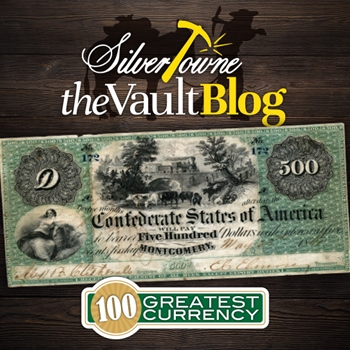
Rare is the name of the game this go ‘round as we continue our blog series covering Whitman Publishing’s 100 Greatest American Currency Notes. With guidance from authors Q. David Bowers and David M. Sundman, we will uncover what makes this one of four denominations to come from the esteemed March 1861 notes issue from the National Bank Note Co.
#53 – 1861 “Montgomery Note” $500 Confederate States of America Note
The $500 “Montgomery Note,” Criswell Type 2, is the second highest denomination of four to come from the March 1861 notes as just 607 sheets were issued from the National Bank Note Co. One of the reasons for its rarity, aside from how many were issued, is that it came from the first capital of the Confederacy. Only 109 examples of the note have been accounted for and most of those remain in higher grades as they never circulated in everyday commerce. Instead, they were treated like bonds or financial investments by those who owned them.
The motif for the $500 note was engraved by James Smillie called, “The Crossing.” The lower left of the face features the goddess of agriculture, Ceres. At one point, the Treasurer of the United States, E.C. Elmore, considered the creation of a Confederate coin design, but no circulating issues were ever produced.
Back during the 1850s and early 1860s, different printing techniques, design preparations, and ink colors were subject to claims that they were used to prevent the alteration of or counterfeiting of notes. However, The National Bank Note Co., had its own foolproof system of dismissing the claims as they were the printer of the four Montgomery issues for the Confederacy. W.L. Ormsby checked into the matter stating that the patent (April 23, 1860) was successful.
The historic market value of the $500 Montgomery Note in 1960 was $600 for a Very Fine condition. The value increased to $50,000 at the printing of this publication (2006).







